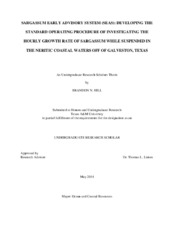| dc.creator | Hill, Brandon Nicholas | |
| dc.date.accessioned | 2014-06-16T15:51:40Z | |
| dc.date.available | 2014-06-16T15:51:40Z | |
| dc.date.created | 2014-05 | |
| dc.date.issued | 2014-01-22 | |
| dc.date.submitted | May 2014 | |
| dc.identifier.uri | https://hdl.handle.net/1969.1/152070 | |
| dc.description.abstract | Sargassum, a pelagic brown alga, is a vital part of marine and coastal ecosystems. It serves as shelter for fish, turtles, and other hatchlings and juveniles. Sargassum acts as a source of food, as it reaches closer to the shorelines, birds will feed on the abundant life that grows throughout its mats. It serves a fundamental role once on the beaches; providing organic material to sustain dune vegetation. Sargassum, while vital to beach health, can become a significant burden to coastal communities if too much washes onto a beach at one time. Prior to making landfall it experiences an extreme spike in biomass increase, and overwhelms the system as it is suspended just off the surf zone. Pelagic brown alga, such as Sargassum, grows in a vegetative manner, absorbing nutrients located within the surface waters through the outer membrane. The nutrient rich coastal Gulf of Mexico waters provide access to such growth-spurring nutrients and serve to accelerate the Sargassum’s growth. This research is addressing the means of attaining an accurate measurement of the growth rate within the depth of closure of Texas coastal beaches. This area is targeted due to the increased mixing of nutrients as predicted by the Hallermeier-equation (Hallermeier 1981).The Sargassum Early Advisory System (SEAS) has the ability to forecast Sargassum events through the observation of the Sargassum within its loop system. In order to increase volumetric accuracy of the forecasts the attainment of an expected rate of growth will be pursued(Webster and Linton 2013). Knowing the expected rate of Sargassum’s growth once entering neritic waters is vital for forecast accuracy in the SEAS project. This information gives researchers the ability to compute the amount of Sargassum projected to make landing with greater volumetric accuracy. This Standard Operating Procedure (SOP) detailing proper measurement attainment methods has been constructed and field tested in the collection of Sargassum’s hourly growth rate data. The preliminary data collected while in this testing phase has indicated a much higher Sargassum growth rate than originally anticipated, as well as revealing some fascinating idiosyncrasies. | en |
| dc.format.mimetype | application/pdf | |
| dc.subject | Sargassum, growth rate, Seaweed, SEAS, TAMUG, | en |
| dc.title | Sargassum Early Advisory System (SEAS): Developing the Standard Operating Procedure of Investigating the Hourly Growth Rate of Sargassum While Suspended in the Neritic Coastal waters off of Galveston, Texas. (May 2014) | en |
| dc.type | Thesis | en |
| thesis.degree.department | Marine Sciences | en |
| thesis.degree.discipline | Ocean and Coastal Resources | en |
| thesis.degree.grantor | Honors and Undergraduate Research | en |
| dc.contributor.committeeMember | Linton, Thomas L | |
| dc.contributor.committeeMember | Webster, Robert | |
| dc.type.material | text | en |
| dc.date.updated | 2014-06-16T15:51:40Z | |


